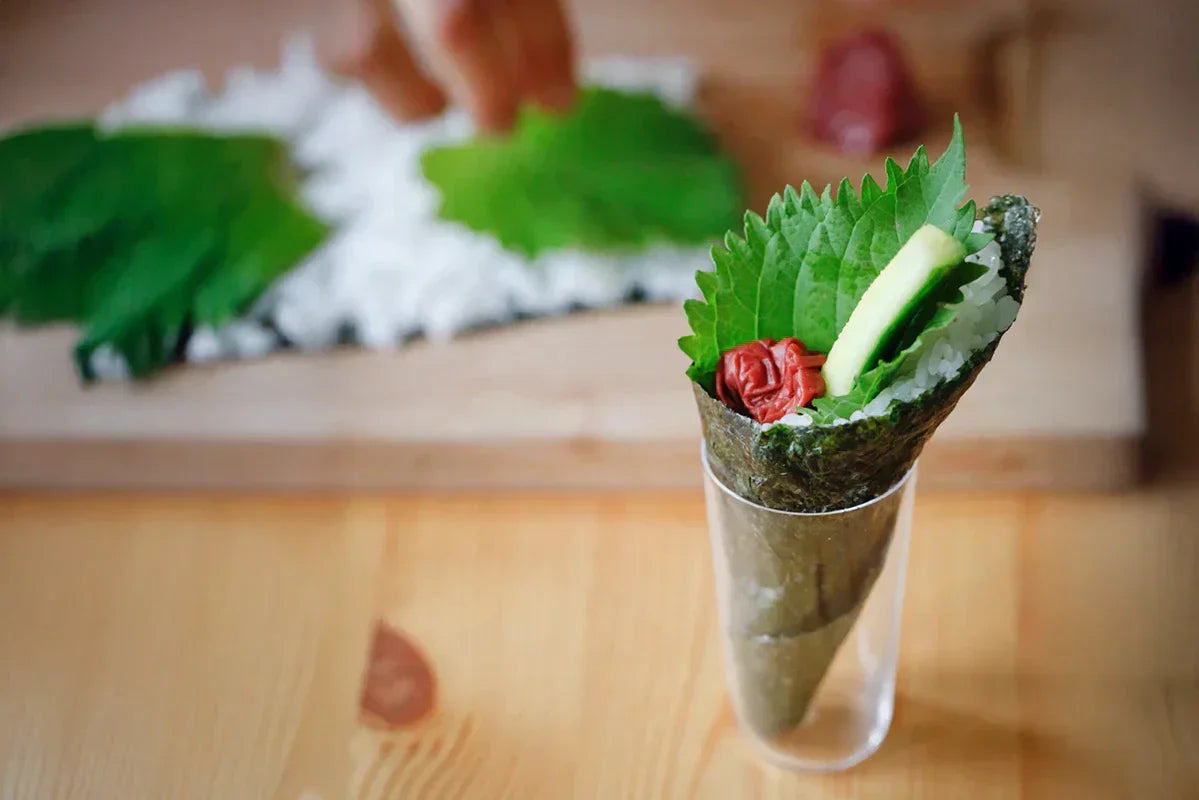
Chef, teacher and friend of The Wasabi Company, Yuki Gomi, talks us through how to make this tactile, no-fuss way to enjoy sushi at home. See more from Yuki at Japanese Food. Simply. All photos by Keiko Oikawa.
Some of the most satisfying meals are the ones you make as you’re sat the table, chatting to friends and family. Think hotpot, Korean BBQ, sukiyaki or a bubbling pot of Japanese shabu-shabu. There’s something about the act of cooking and eating together, all at once, that brings a meal to life. Te maki, the Japanese hand roll, belongs in that same family. No great fuss, no need for a chef’s training. Just rice, seaweed, a few good fillings and the natural rhythm of hands moving around a table.
Te maki (手巻き) translates simply to “hand-rolled,” and it lives at the more casual end of the sushi world. Unlike neat little slices of maki or the precise press of nigiri, te maki is a cone of rice and fillings wrapped in nori, made one at a time and eaten just as quickly. You don’t need a bamboo mat. You don’t need a knife. Just tear the seaweed in half, scoop a little warm rice onto one side, add what you fancy and roll it up into a point. Done. The shape is charming, a bit rustic, and perfectly made for fingers rather than chopsticks.
It’s a style of sushi that’s as popular at home as it is in takeaway shops, especially in Japan, where people often make it for lunch or relaxed gatherings. In London, there’s a surge in their popularity, I enjoyed Chef Endo’s signature Wagyu beef te maki rolls recently at Kioku - seriously delicious! In New York, I’d love to visit Nami Nori in the West Village. It’s become a destination for their modern, open-style hand rolls, served one at a time, from the pictures I’ve seen they look seriously fresh and beautiful, have you been? Drop a note in the comments if you have, or anywhere else you’ve had te maki recently. And of course, in Tokyo, te maki is everywhere, at family dinner tables, school lunches and izakaya counters.
What makes te maki particularly lovely is how little you need to prepare. Cook a batch of sushi rice, season it with rice vinegar, sugar and salt, and let it cool slightly. Lay out half-sheets of nori. Then just add the fillings. Avocado, cucumber, cooked prawns or tuna mayonnaise, strips of tamagoyaki, smoked salmon, pickled daikon. If you can find sashimi-grade fish, try thin slices of salmon, tuna or yellowtail. If not, use smoked instead. Their a great way to enjoy local ingredients. I remember making these in Alnwick, Northumberland using smoked kippers and smoked salmon from L. Robson in Craster. Perhaps just tone down the salt and soy sauce a little, as there’s plenty in smoked fish. No one roll needs much fish, and a little variety goes a long way.
In summer, you might lean towards fresh vegetables and lighter seafood. Think gem lettuce, blanched green beans, shredded crab with a little yuzu or lemon. In winter, heartier options shine, soy-braised shiitake, or slivers of grilled mackerel. If you’re making a vegetarian spread, marinated tofu or natto are both satisfying and traditional. And if you’ve got children at the table, it’s a brilliant way to involve them in dinner without pressure. Everyone gets to choose what they like.

The texture is half the joy. That first bite into crisp nori, giving way to warm, gently vinegared rice, then into whatever filling you’ve picked, creamy, crunchy, savoury or sharp. Each roll is a small surprise. And since you’re making them one by one as you eat, the seaweed never has time to go soft. It stays fresh and crackly, like biting into autumn leaves.
A good te maki evening can feel almost like a party, even when there’s no occasion at all. In Japan, families often make it for special days like Setsubun or Hinamatsuri, but just as often, it’s a weeknight meal. There’s no need for a centrepiece or a main course. Just bowls and plates and laughter as everyone builds their own. If you’re serving them at a party or as canapés, a fun trick is to stand them up in shot glasses. They hold their shape nicely and look elegant.

One under appreciated filling is umeboshi, the pickled Japanese plum. It’s salty, sharp and intensely sour, with a deep rose colour from the shiso leaves it’s fermented with. It won’t be to everyone’s taste, but if you like bold flavours, try it with plain rice and a sliver of cucumber or shiso leaf. It cuts through richness and adds a palate-cleansing brightness to the table. Umeboshi is also thought to aid digestion and was once carried by samurai as a kind of tonic, tucked into rice balls on long journeys. I’m making a huge batch at the moment using Turkish apricots, little ones, that are so beautifully coloured. I’ll post about these soon, once I see how the recipe turns out!
In this recipe, I combine umeboshi with cucumber and shiso leaves. It’s a very summery style of te maki. The crucnh of cold cucumber is refreshing and you could use shiso leaves that you’ve grown at home. The Wasabi Company sell little shiso plants, in purple and green.
As with any tactile dish, there are a few gentle rules. Use cold water on your hands when handling the rice to keep it from sticking. Don’t overfill. Let a little of the filling poke out from the side of the nori, it looks beautiful and helps signal what’s inside. And eat your roll straight away. The whole point is that it’s crisp and fresh, just for you, just at that moment.
Some meals become traditions without us realising it. They creep into our lives because they’re easy, comforting and quietly joyful. Te maki is one of those. It doesn’t ask for much, but it gives a lot. Whether you’re rolling one just for yourself at lunchtime or setting out a spread for friends, it brings the kind of warmth that only shared food can. Nothing complicated. Just a cone of rice and something good inside, ready to be eaten with your hands and a smile.

A (very) Brief History
The evolution of sushi is long and layered. From ancient methods of preserving fish in fermented rice to the dazzling variety of sushi found today across Japan and beyond. Te maki, however, is relatively modern. It is thought to have emerged during the Edo period (1603 to 1868), when sushi began to transition from preservation method to street food.
As sushi became more portable, te maki naturally followed. It was a tidy cone you could hold in your hand, often wrapped and eaten on the go. Today, it is especially common in homes and casual eateries, particularly for lunch or relaxed gatherings. Unlike the elegantly sliced rolls you find in high-end omakase restaurants, te maki is homespun and unpretentious. Yet it remains deeply satisfying in its own right.
Some of my Te Maki tips:
- Try a variety of fillings. You never know what unlikely combinations you might love.
- Use cold water for your hands when handling rice. Sushi rice is sticky by design, but water will stop it from clinging too much.
- Don’t overfill. A small handful of rice and a few strips of filling is more than enough.
- Leave a little bit of filling sticking out of the nori. It’s visually appealing and helps indicate what’s inside.
- Eat immediately. The joy of te maki lies in that first crunch of nori, which softens quickly.
- Skip the soy sauce if your roll has strong, acidic ingredients like umeboshi. It’s likely to overpower rather than enhance.
 How to make Te Maki
How to make Te Maki
Umeboshi and Cucumber with Shiso Te Maki – Japanese Pickled Plum and Cucumber with Shiso Leaves Hand Roll – 梅ときゅうり手巻き
Umeboshi are pickled plums, found in jars in most Japanese homes. My grandparents had an ume (plum) tree in their garden and made their own pickles. I love to use umeboshi in sushi as they have a very sour taste that works well with other ingredients, such as cucumber and aromatic shiso leaves. They are also eaten with rice or as a side dish. As with jam or chutney, everyone has their own family recipes for umeboshi, but you can buy them ready-made at Asian supermarkets and some health-food shops. Or try ume paste too, which works just as well!
Ingredients
Makes 4 rolls
- a bowl of cold water for your hands
- a 4cm-long piece of cucumber
- 4 teaspoons of ume paste, or 4 whole umeboshi (destoned)
- 2 sheets of nori
- 4 small handfuls (roughly 200g) of sushi rice
- 4 shiso leaves
Method
Cut the piece of cucumber lengthways into 4 and remove the seeds carefully with a spoon or a knife. Cut the sticks lengthways into half again, so that you have 8 sticks of cucumber. You will need 4 sticks for this recipe, so wrap and store the rest for 1–2 days to use in other sushi. If you are using whole umeboshi, mash them with the back of a teaspoon.
You will be able to see some thin lines on the nori seaweed sheets. Following one of these lines, cut each sheet in half using scissors, but be very careful as the sheets break easily. Place a half-sheet of nori shiny side down on your hand, with a short edge closest to you.
Wet the fingers of your other hand in the bowl of water, and shake off any excess. Damp fingers help when using sticky sushi rice. Pick up the small handful of rice and quickly spread it over the bottom half of the nori sheet. It does not have to be spread as neatly as the other types of rolls in this book. Place a stick of cucumber diagonally in the middle of the rice, with an umeboshi and a shiso leaf on top.
Bring the bottom corner of the nori that is closest to you over the filling, to meet the rice on the other side, making a triangle. You can then roll the plain side of the nori sheet around it to make a nice ice-cream-cone shape.
Tips
Umeboshi can have a very strong acidic and salty flavour, so you might not need to use soy sauce as a dip when you eat your roll.
This article was originally published on Japanese Food. Simply. by chef and teacher Yuki Gomi.
Yuki blends traditional and modern techniques to make Japanese cooking approachable and delicious.
Buy one of our DIY Sushi Kits and receive a voucher for 50% OFF one of Yuki’s great courses in Japanese cooking.


